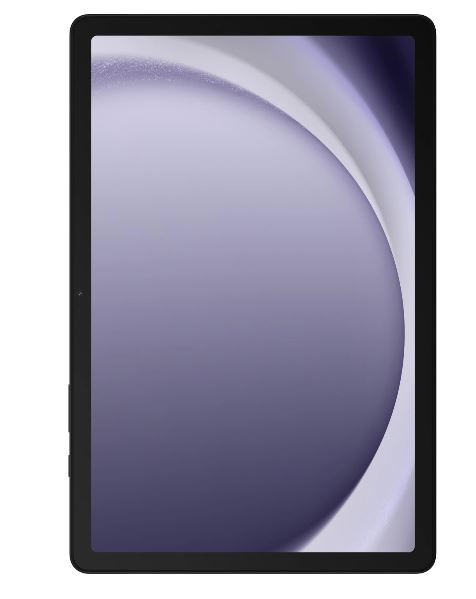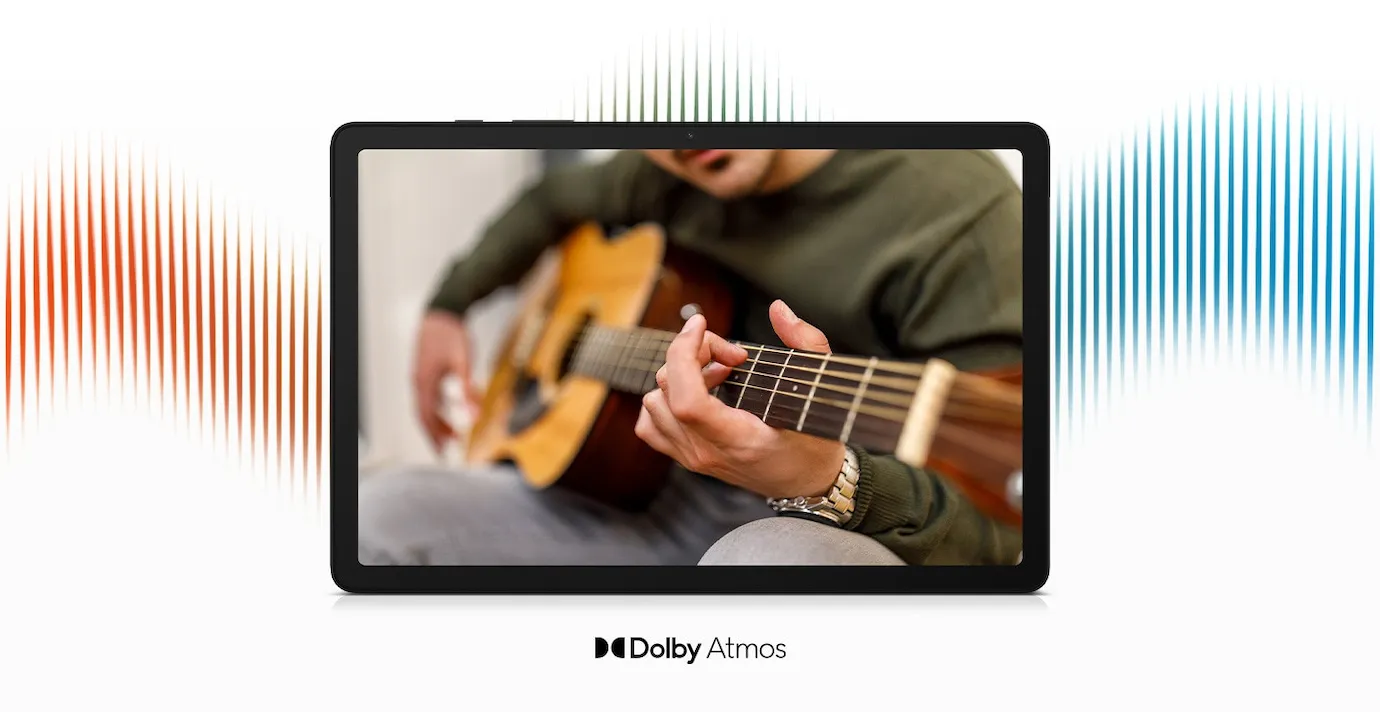



















£199.00*
- Diagonal 11"
- Internal Memory 128 GB
- RAM 8 GB
- wireless technology WiFi, Bluetooth


Product information
The Samsung Galaxy Tab A9+ SM-X210 tablet is characterised by its very affordable features. It will deliver outstanding performance in all everyday applications. It has an 11-inch screen with a high refresh rate of 90 Hz, a good Snapdragon 695 processor, 8 GB of RAM and a 128 GB hard drive as well as a large battery (7040 mAh).
Technical specification:
- Screen: 11", TFT, 1920 x 1200 pixels
- Operating system: Android 13
- RAM and drive: 8 GB RAM + 128 GB drive
- Processor: Qualcomm Snapdragon 695, 8-core
- Battery/battery capacity: 7040 mAh
- Wireless connectivity: Bluetooth 5.1, Wi-Fi 5 (802.11ac)
Sleek and modern design
The Galaxy Tab A9+ has a sleek design and a smooth metal body that gives them a touch of elegance. Enjoy Samsung's signature tablet design in Graphite, Silver and Navy colours, each hue enhancing the effortless charm.
Brilliant colours and smooth picture
Experience entertainment on a large, bright display. Immerse yourself in an impressive visual world with a high refresh rate that ensures fluid and smooth movements on your Galaxy Tab A9+. Even when you're out in the sun, you can enjoy your favourite content in impressive quality.

What you love, hold on to
The Galaxy Tab A9+ is equipped with up to 8 GB of RAM. So you can complete multiple tasks at the same time without any delays. The integrated 128 GB memory stores your high-resolution videos, photos and files. You can even expand the memory by up to 1 TB with a microSD card - for plenty of space for what's important to you.

Split screen for high productivity
For your productivity - With the Galaxy Tab A9+ you can draw sketches, select captivating images and have video chats at the same time. Open up to three apps on your display without having to close a window.

Enveloping worlds of sound
Immerse yourself in a world of sound with speakers that surround you with immersive sound from all sides. Whether you're watching a film or listening to your favourite music, the Galaxy Tab A9+ lets you fully immerse yourself in 3D sound with impressive clarity and depth.

Protect what's important to you
Keep your information safe and secure. Save important data in the Secure Folder and monitor the general security status of your device on the data protection dashboard. Keep an overview and feel secure - with your Samsung Galaxy.
Technical data
| Name | Samsung Galaxy Tab A9+ X210 128GB WIFI |
|---|---|
| Article number | 1000033308 |
| GTIN/EAN | 8806095360829 |
| Model name | Galaxy Tab A9+ |
| Brand | Samsung |
| Product Type | Tablet |
| Resolution | 1920 x 1200 WUXGA Resolution Resolution: The resolution of a projector is the maximum number of image points (pixels) that a projector can display based on its naturally existing technology, i.e. without conversion or cropping of the image. The native resolution is the number of pixels that a projector physically has to display the image. A projector usually interpolates a resolution when it receives an image signal with a higher resolution than the native one. If this is the case, there may be a lack of image detail or general blurring in the displayed image. If a projector receives an image signal with a lower resolution than the native, it also interpolates, it scales the image up to the native resolution, calculates corresponding additional pixels, if possible without changing the image information. The disadvantage here is that although the image is displayed larger than fed, the original individual pixels may become much more visible as they are multiplied by the conversion. 4K: 4K refers to the resolution of 3840 x 2160 or Ultra High Definition Television (UHDTV). This resolution corresponds to 4 times the resolution of Full HD. To record films with this resolution, special cameras are needed that can record at around 8 megapixels (4K). Full HD: The term Full HD is used to describe devices that can physically display or output HDTV signals in full (1920 x 1080 pixels). 1080p: 1080p is the specification of the vertical picture lines. Among other things, it refers to the resolution 1920 x 1080. The "p" in this case means full frames, so all picture lines are displayed simultaneously. 1080i: 1080i is the specification of the vertical picture lines. The "i" in this case means fields. This signal is usually displayed interpolated (e.g. by devices with a 1280 x 720 HDready resolution). The interpolation digitally adds pixels, but also offers a slight blurring. In contrast, 1080p playback uses full frames. |
| Diagonal | 11" |
| Operating system | Android |
| RAM | 8 GB |
| Internal Memory | 128 GB |
| Camera resolution | 8 MP |
| Inputs | 1x 3,5mm Jack , 1x USB-A Inputs HDMI: Digital connection for the transmission of picture & sound. Necessary for high-resolution picture quality (HDTV). Since HDMI 1.4 (High Speed) suitable for transmission of 3D content in Full HD. For high-resolution picture quality in UHD, 4K or HDR, the connection via HDMI 2.0a and higher is suitable. HDMI 2.1 or higher should be used from 120Hz refresh rate in 4K. VGA: The VGA connector is a 15-pin connector for analogue image transmission. It is also called DSub15 and is often found on notebooks and PCs. Compared to the other analogue connections, it offers good picture quality. It can be screwed to the input or output device and can be adapted to YUV with a suitable configuration. DisplayPort: The DisplayPort connection is a VESA-standardised connection for the transmission of image and sound data. In addition to HDCP encryption, DPCP is also supported. Due to its compact size, the connection is most commonly used in notebooks. An extra small variant is the MiniDisplayPort, which is used especially with Apple devices. DVI: DVI (Digital Visual Interface) is an interface for the transmission of video data. Only analogue signals can be transmitted via DVi-A, only digital signals via DVI-D and both types of signals via DVI-I. USB: USB (Universal Serial Bus) is used to control and manage the projector (USB-B). With some business devices, office files and images can also be presented directly with a USB stick or a mouse can be connected via the USB input (USB-A). Toslink: The Toslink connection is an optical signal connection that works on an optical fibre basis. It is used for the digital transmission of audio signals. The optical design offers a lower susceptibility to interference from external magnetic and electrical influences. The connection is mostly used in the area of DVD / Blu-ray players and comparable devices in connection with an AV receiver, if these work with dts or Dolby Digital signals. YUV: The YUV connection, also called Y Cb/Pb Cr/Pr or component connection, is an analogue video connection with three channels (light intensity and two colour channels). Qualitatively, it is the best analogue video connection. Component cable: The YUV connector transmits analogue signals over three cables (Y=black and white UV=colours). YUV is used to transmit HDTV and is compatible with Cinch, for example. S-Video: The S-Video connection is also called S-VHS or Hosiden connection. Compared to the Cinch video connection, it works with two channels (brightness/colour). In terms of quality, it is somewhat better than the Cinch video connection, but there are also limitations. These can be explained by the susceptibility of the signal, which is reflected in picture distortions, for example. Cinch: The cinch video connection is also called composite connection. To make it easier to recognise, it is usually sheathed in yellow. Since the transmission is only via one channel, the picture quality is on a low level. D-Sub15: The VGA connector is a 15-pin connector for image transmission on an analogue basis. It is also called DSub15 and is often found on notebooks and PCs. Compared to the other analogue connectors, it offers good picture quality. It can be screwed to the input or output device and can be adapted to YUV with a suitable configuration. RS232: The RS232 interface can be used to control or manage the projector. Mini Jack: With a single-pin Mini Jack, mono audio signals can be transmitted, with a two-pin stereo audio signals and with a three-pin stereo audio signals and image data can be transmitted. Scart: Scart is a connector that can be used to transmit analogue audio and video signals. It is compatible with other analogue connections such as RCA or S-Video. ARC: The audio return channel, also called ARC or audio return channel, was introduced with HDMI version 1.4 to reduce the amount of cabling between HDMI components. The audio return channel runs via the existing HDMI cable. Therefore, an additional cable for the sound no longer needs to be connected. However, both devices must support ARC. All audio file formats that are also transmitted via the SPDIF interface can be transmitted via the audio return channel. These include Dolby Digital, Digital Theatre Sound and PCM audio. As an example, a connection between a TV (including receiver) and an AV receiver could be made via an HDMI cable. The sound from the TV is fed back via the HDMI cable. Previously, an additional digital cable (coaxial or Tos-Link) was required for the audio signals. |
| wireless technology | Bluetooth , WiFi wireless technology WLAN: WLAN (Wireless Local Area Network) refers to a wireless network. For example, projectors or displays can be connected wirelessly to various sources (notebooks, smartphones, etc.) to realise wireless image transmission. In some cases, additional components (dongles/adapters) are required for this if a wireless connection is not directly supported. AirPlay: Apple's AirPlay technology is used for wireless transmission of content, such as music and videos, from iOS and Mac devices. These can also be receiver devices such as speakers, AV receivers and stereo systems or TVs. Streaming also works from an iOS device to a matching receiver. The protocol developed by Apple can also be licensed by other manufacturers. iProjection: With the free Epson iProjection app, projectors can be operated remotely and office content and photos can be projected. The app is compatible with current Epson business projectors and can also be used as a practical remote control. Other features of this functionality include searching for available projectors, volume control, mute, and a freeze function to freeze the current image of a presentation. The most important Office contents, such as Word, Excel, PowerPoint, Keynote and PDF files, are supported and can be played back directly from the medium. Images in JPEG and PNG format can also be presented directly. The Epson iProjection app is available for download free of charge from the Apple App Store and the google Play Store. Easy MP: A special network function from Epson. The Easy MP function allows you to present efficiently over multiple computers via an existing network. Easy MP allows you to transfer a presentation, images as well as audio data via the network and thus receive a selection from various sources in the network. |
| Product width | 25.71 cm |
| Product height | 16.87 cm |
| Product depth | 0.69 cm |
| Weight | 0.48 kg |
| Colour | Grey |
| Condition | New |
| Warranty type | Bringin service Service and support information |
Manufacturer's warranty information:
Here you will find more detailed information on the different types of warranty. Please refer to our manufacturer overview for contact details and warranty conditions for the corresponding warranty claim. Statutory warranty rights are not restricted by an additional manufacturer's warranty. Our liability for defects is governed by law. Defect rights can be claimed free of charge.



